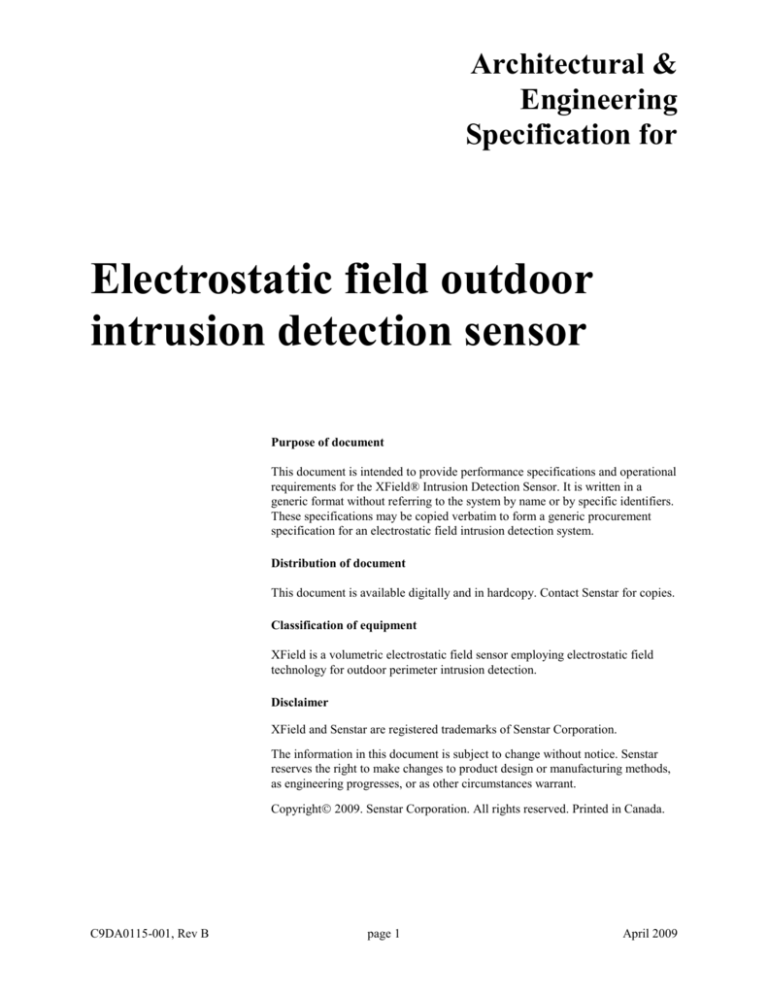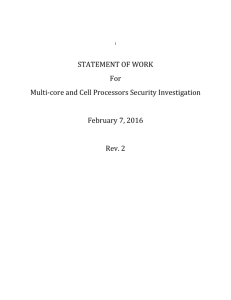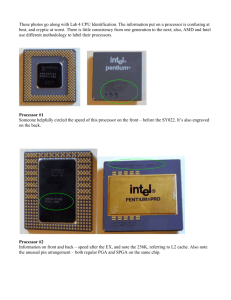
Architectural &
Engineering
Specification for
Electrostatic field outdoor
intrusion detection sensor
Purpose of document
This document is intended to provide performance specifications and operational
requirements for the XField® Intrusion Detection Sensor. It is written in a
generic format without referring to the system by name or by specific identifiers.
These specifications may be copied verbatim to form a generic procurement
specification for an electrostatic field intrusion detection system.
Distribution of document
This document is available digitally and in hardcopy. Contact Senstar for copies.
Classification of equipment
XField is a volumetric electrostatic field sensor employing electrostatic field
technology for outdoor perimeter intrusion detection.
Disclaimer
XField and Senstar are registered trademarks of Senstar Corporation.
The information in this document is subject to change without notice. Senstar
reserves the right to make changes to product design or manufacturing methods,
as engineering progresses, or as other circumstances warrant.
Copyright 2009. Senstar Corporation. All rights reserved. Printed in Canada.
C9DA0115-001, Rev B
page 1
April 2009
Architectural & Engineering Specification
for Electrostatic Field Outdoor Intrusion Detection Sensor
Contents
April 2009
1.0
General performance specifications .......................3
2.0
Sensor processor specifications .............................7
3.0
Centralized control & maintenance .................... 11
4.0
System installation and commissioning .............. 12
5.0
System maintenance and repair ........................... 13
6.0
Product certifications .......................................... 14
7.0
System availability .............................................. 15
page 2
C9DA0115-001, Rev B
Architectural & Engineering Specification
for Electrostatic Field Outdoor Intrusion Detection Sensor
1.0
General performance specifications
1.1
System description
The system shall be a modular electrostatic field outdoor intrusion detection
sensor system based on very low frequency (VLF) electronics technology. An
invisible volumetric electrostatic detection field shall be formed between sets of
parallel wires. The detection field shall be capable of detecting the presence of a
human intruder passing through it.
A field generator shall excite field wires to create an electrostatic field. Parallel
sense wires shall pick up and carry the signals from the detection field back to
the processor. The processor shall detect minute changes in the coupling that is
caused by the presence of an intruder within the electrostatic field. The signal
processor shall include both the generator and detector circuitry and shall be
capable of monitoring either one or two detection zones as a standalone unit.
All processors shall provide the ability to adjust parameters using a laptop PC
connected directly to the processor via a Universal Serial Bus (USB) cable.
The processor shall be capable of communicating alarm, status, and
configuration information over a data network. The data network supported by
the system shall be managed by a central network interface unit that provides
standard communications interfaces for connection to computer equipment. Via
the network interface unit and associated network management software the
system shall provide all the alarm and status information needed to implement
the operator interface. In addition, configuration software shall be available so
that all system calibration and adjustments can be done over the data network
from a central location.
1.2
System technology
1.2.1
Electrostatic field
An AC signal that is generated along the field wires couples to the sense wires
establishing an electrostatic field. The signal processor shall analyze the signals
picked up by the individual sense wires to detect the presence of intruders within
the field. The signal processor shall use digital processing and adaptive
algorithms to nullify the effects of induced voltages from power lines, distant
lightning, electromagnetic noise and environmental effects.
1.2.2
Field and sense wires
The field and sense wires shall be made of 316 stainless steel wire and shall be
mounted on insulators. The insulators shall be mounted so that the wires are
parallel and form a barrier. A typical installation shall employ 2 field wires and 2
sense wires (see Section 1.4.2). It shall be possible to add a fifth wire to increase
the height of the 4-wire configuration. It shall be possible to create an 8-wire
configuration by stacking two zones, one on top of the other, to achieve greater
field heights. The insulators and wires shall be capable of being mounted on
fences, and freestanding posts adjacent to, or between, physical barriers.
C9DA0115-001, Rev B
page 3
April 2009
Architectural & Engineering Specification
for Electrostatic Field Outdoor Intrusion Detection Sensor
1.3
Detection properties
1.3.1
Detection sensitivity
The system shall detect intruders with a significant mass and velocity while
rejecting other environmental stimuli.
1.3.2
Detection performance
1.3.2.1 Probability of detection (PD)
The probability of detecting an upright human intruder passing through the
perimeter at random locations shall be 90% with a 95% confidence factor.
1.3.2.2 Velocity response
The system shall be capable of detecting human intruders moving through the
detection field at speeds ranging from 5 cm/s (2.0 in./s) to 5 m/s (16.4 ft./s)
regardless of the direction of motion.
1.3.2.3 Intruder weight
The system shall detect human intruders weighing 35 kg (77 lb.) or more at the
specified PD.
1.3.2.4 Crossing types
The system shall detect human intruders who walk, crawl, roll, jump or run
through the detection field.
1.3.3
False/nuisance alarms
False/nuisance alarms are divided into three categories: system-generated, small
animal and environmental.
1.3.3.1 System-generated alarms (false alarms)
Alarms generated by internal electronic processes (wires excluded) shall occur at
a rate of less than one per zone per month (averaged over the total number of
zones in the system).
1.3.3.2 Small animal alarm rejection
The probability of detecting a small animal, weighing less than 5 kg (11 lb.),
crossing the perimeter shall be less than 10% with a confidence factor greater
than 90%, provided the animal does not physically touch any field or sense wire.
April 2009
page 4
C9DA0115-001, Rev B
Architectural & Engineering Specification
for Electrostatic Field Outdoor Intrusion Detection Sensor
1.3.3.3 Environmental alarms (nuisance alarms)
The system shall operate within specifications in typical outdoor environments.
The system must be installed in accordance with the manufacturer's guidelines to
minimize the possibility of nuisance alarms while maintaining the full PD for
valid intruders. The following conditions shall not affect the system’s PD:
rain
sunrise/sunset
wind
temperature changes
snow
hail
fog
sandstorms
motion of nearby objects (vehicles, etc.)
nearby radio-frequency sources
seismic vibration
acoustic or magnetic effects
The manufacturer shall provide system documentation, which includes detailed
information on site planning, installation, operation and maintenance.
1.4
Sensor characteristics
1.4.1
Zone length
The maximum length of each individual detection zone shall be 152 m (500 ft.).
The minimum zone length shall be 3.0 m (10 ft.).
1.4.2
Detection field dimensions
The effective detection field shall be continuous and uniform over the protected
site perimeter. The typical cross-section of the detection field shall exhibit the
following dimensions when the system is calibrated in accordance with the
manufacturer’s recommendations:
Height – up to 2.5 m (8.0 ft.) above ground, based on a four wire
configuration in a fence-mounted installation. Up to 3.65 m (12 ft.) above
ground, based on a five wire configuration in a fence-mounted installation.
Up to 5.65 m (18.5 ft.) above ground, based on an eight wire configuration
in a fence-mounted installation
Width – up to 1.0 m (3.3 ft.) centered on the plane of the wires
Note: The height and width dimensions are typical and depend upon the
threshold setting and site conditions.
C9DA0115-001, Rev B
page 5
April 2009
Architectural & Engineering Specification
for Electrostatic Field Outdoor Intrusion Detection Sensor
1.4.3
Terrain-following characteristics
The detection field shall not be limited to line-of-sight operation. The zone
length, detection field dimensions and performance characteristics shall be valid
over uneven terrain including grade changes and acute corners. Steep grade
changes shall be possible with the installation of additional interim points.
1.4.4
Range of containment
When the system is adjusted to demonstrate sensitivity according to the
manufacturers' recommendations, the detection field shall not detect a valid
human target that is 1.5 m (5 ft.) or more from the plane of the wires.
April 2009
page 6
C9DA0115-001, Rev B
Architectural & Engineering Specification
for Electrostatic Field Outdoor Intrusion Detection Sensor
2.0
Sensor processor specifications
2.1
Processor description
The signal processor shall contain the electronics necessary to perform the
generation, reception and digital signal processing for one or two detection
zones. The processor shall operate in either a standalone configuration or in a
network configuration. The unit will be housed in a weatherproof NEMA 4 or
equivalent enclosure, when installed outdoors.
2.2
Signal processor operation
2.2.1
Distributed processing
Signal processors distributed along the perimeter shall perform the generation,
reception and digital signal processing of the electrostatic detection field. The
failure of one processor shall not affect the other processors along the perimeter.
Each processor shall provide coverage for up to 305 m (1000 ft.) of perimeter.
The processor shall contain circuitry and firmware to prevent interference
between adjacent fields.
2.2.2
Adaptive filter
The processor shall use an adaptive filter and signal analysis to identify and
screen out environmental factors such as rainfall that could lead to nuisance
alarms.
2.2.3
Total perimeter length
Total perimeter length shall be expandable from the 305 m (1000 ft.) maximum
coverage of one processor to an unlimited length using multiple processors.
There shall be uniform coverage and no gap in the detection field between
individual zones.
2.2.4
Standalone mode
The signal processor shall identify, by type and zone, Intrusion, Supervision and
Fail alarms locally via dry relay contacts (Form C) rated at 1.0 A, 30 VDC.
An alarm caused by intrusion into the detection zone shall be identified as an
Intrusion alarm.
Alarms caused by tampering with the field and sense wires or by opening the
enclosure shall be identified as Supervision alarms. Supervision alarms shall be
distinctive from all other alarms and shall continue until the fault is corrected.
Alarms caused by power failure or internal electronic failure shall be identified
as Fail alarms. Fail alarms shall be distinctive from all other alarms and shall
continue until the fault is corrected.
C9DA0115-001, Rev B
page 7
April 2009
Architectural & Engineering Specification
for Electrostatic Field Outdoor Intrusion Detection Sensor
The Fail and Supervision relays shall operate as failsafe. During normal
operation, both relays shall latch in the non-alarm state. Upon total system
failure both the Supervision and Fail relays shall switch to the alarm state to
annunciate the system failure.
The processor shall be capable of performing an electronic self-test of either
zone by local activation.
2.2.5
Network mode
In network mode, the processors shall be connected by 4-wire EIA-422 twisted
pairs, or dual multimode fiber optic cables, or dual singlemode fiber optic cables
for the transmission, reception and central display of Sensor alarms, Supervision
alarms and Fail alarms, as described in 2.2.4. The system shall support redundant
data paths. Network functionality shall be achieved by employing Auxiliary
Interfaces as described in 2.2.6.
2.2.6
Auxiliary interfaces
In network mode, each processor shall be capable of supporting optional internal
interfaces to collect or distribute data from auxiliary sensors, to provide power to
auxiliary sensors, and to provide redundant data communication over EIA-422
or fiber optic data paths.
2.2.6.1 Optional data collection/distribution interfaces
The processor shall be capable of supporting either an auxiliary input card, or a
relay output card. A plug-in input card shall be available to provide eight (8)
supervised inputs for the collection of data from auxiliary sensors. A relay output
card shall be available to provide eight (8) Form C dry contact relay outputs,
rated at 1.0 A at 30 VAC/VDC. In addition, there shall be available on the
processor itself, two supervised inputs and four relay outputs rated at 1.0 A at
30 V, non-inductive load.
2.2.6.2 Optional Power interface
A DC-DC power converter shall be located in the processor enclosure to convert
24 or 48 VDC from the power network to 12 VDC, 150 mA maximum, to power
external devices.
2.2.6.3 Optional Communications interface
Separate plug-in communication interfaces shall be available for EIA-422,
multimode fiber optic, and singlemode fiber optic bi-directional data
communications.
April 2009
page 8
C9DA0115-001, Rev B
Architectural & Engineering Specification
for Electrostatic Field Outdoor Intrusion Detection Sensor
2.3
Environmental conditions
The signal processor shall operate within specifications in the following range of
conditions:
Temperature: –40ºC to 70ºC (–40ºF to158ºF)
Humidity: 10 to 95%, non-condensing
2.4
Powering Requirements
The signal processor shall be capable of being powered at 10 to 52 VDC at
6 W maximum.
2.4.1
Backup battery
Each processor shall be equipped with an internal 6 VDC, 5 Ah (nominal)
battery to provide emergency backup power in the event of a power failure. The
processor shall include charging circuitry to maintain the battery at full charge.
2.5
Physical installation criteria
2.5.1
Physical installation
The field and sense wires shall be tensioned at the start of the zone, at the end of
the zone, and at 50 m intervals throughout the zone, and shall be supported every
6 m (20 ft.) or less, depending on the environmental conditions (strong wind).
The wires shall be capable of being mounted in the following configurations:
Fence-mounted - on an existing, or new, perimeter fence
Freestanding - on freestanding poles either in an open area within a
controlled perimeter, or in the area between two barriers along a perimeter
2.5.2
Determination of zone length
The length of each zone shall be determined by the physical boundaries of the
site to a maximum length of 152 m (500 ft.).
2.5.3
Location of signal processor
The signal processor shall be mounted inside the protected perimeter, away from
the fence, within 150 m (492 ft.) of the start of the zone.
2.5.4
Enclosures
For outdoor installations, the signal processor shall be housed in a weatherproof
NEMA 4 (or equivalent) enclosure. The enclosure shall be capable of being
mounted on walls and posts.
C9DA0115-001, Rev B
page 9
April 2009
Architectural & Engineering Specification
for Electrostatic Field Outdoor Intrusion Detection Sensor
2.5.5
Lightning protection
The signal processor shall include internal components to protect circuitry from
electrostatic discharge (ESD) and lightning. This protection shall include, but not
be limited to, relay contacts, input power, sensor input and field output. The
installer shall provide an approved, low resistance earth ground at each
processor that is properly connected to the enclosure, in accordance with local
regulations.
2.6
Sensor calibration
Each detection zone shall be capable of being calibrated from its respective
signal processor. All calibration adjustments shall be performed using
Windows® based software on a laptop PC connected directly into the processor
via Universal Serial Bus (USB) cable. During calibration, the PC shall display
information about each parameter as it is adjusted.
Access to the USB connector on the processor shall require opening the
enclosure’s cover. This action shall cause a Supervision alarm to be generated.
2.6.1
Network transponder/device calibration (optional)
In a networked system, there shall be a single point interface between the
networked processors and the operator interface.
When the processor is configured as a network transponder/device, it shall be
capable of being calibrated remotely from the central control and display system.
The central control and display system shall also monitor and control the entire
perimeter security system from a central location. It shall also be able to display
sensor system diagnostic test results.
April 2009
page 10
C9DA0115-001, Rev B
Architectural & Engineering Specification
for Electrostatic Field Outdoor Intrusion Detection Sensor
3.0
Centralized control & maintenance
The sensor shall provide an integrated data networking capability to allow it to
be integrated into a centralized control and maintenance facility.
3.1 Network characteristics
The data network shall be capable of communicating all alarm, status, and
configuration information between the processors and a network interface unit.
The data network shall use a loop topology with separate Transmit and Receive
point-to-point links between processors, or between a processor and other
compatible equipment such as the network interface unit. The following physical
media options shall be available for the point-to-point links:
EIA-422
multi-mode fiber
single-mode fiber
It shall be possible to link up to 32 processors together into one network.
The data network shall be managed by a central network interface unit that
provides standard communications interfaces for connection to computer
equipment. The standard interfaces available from the network interface unit
shall be EIA-232, USB, and Ethernet. Via the network interface unit and
associated network management software the system shall provide the alarm and
status information needed to implement an operator interface. It shall be possible
to attach a network interface unit to one processor, or to two processors, to
provide redundant data paths to the processor network.
The supplier’s configuration software shall be capable of using the data network
so that all system calibration and adjustments can be done from a central
location.
It shall be possible to have multiple networks, each with up to 32 processors,
managed by multiple instances of the network interface unit and associated
software, all reporting to one control and maintenance display system.
3.2 Network management software
The supplier shall make available network management software that runs on a
Windows® PC to control the flow of information on the data network. The
network management software shall control the network via the network
interface unit and provide a software interface that provides access to all alarm,
status, and configuration information. The software interface shall be
implemented via TCP/IP.
The supplier shall make available complete documentation of the software
interface provided by the network manager software to enable integration with
third-party Security Management Systems.
C9DA0115-001, Rev B
page 11
April 2009
Architectural & Engineering Specification
for Electrostatic Field Outdoor Intrusion Detection Sensor
4.0
System installation and commissioning
The system shall be installed and commissioned in accordance with the
manufacturer’s recommended procedures, as defined in the Product Guide.
The manufacturer shall make available training programs for site planning,
installation, operation and maintenance of the system. Prior to installation, the
installer shall have completed a training program and be certified by the
manufacturer. Alternatively, the manufacturer shall make available to the
installer, qualified technical support for the installation and commissioning of
the system.
The manufacturer shall make available standard acceptance test procedures to
demonstrate that the system meets the specified probability of detection when
installed and calibrated according to the manufacturer’s directions.
April 2009
page 12
C9DA0115-001, Rev B
Architectural & Engineering Specification
for Electrostatic Field Outdoor Intrusion Detection Sensor
5.0
System maintenance and repair
System maintenance shall include periodic visual inspections of the site, tension
measurement of the sensor wire and operational checks of the effectiveness of
the detection zones.
Outdoor mechanical assembles such as wires, mounting hardware and insulators
shall be self-cleaning and shall be constructed of materials not prone to decay
when exposed to the elements.
5.1
Product support
The manufacturer shall provide technical support and warrant that spare parts
and assemblies shall be available for a minimum of 10 years.
C9DA0115-001, Rev B
page 13
April 2009
Architectural & Engineering Specification
for Electrostatic Field Outdoor Intrusion Detection Sensor
6.0
Product certifications
The quality management system of the product’s manufacturer shall have current
ISO 9001-2000 certification.
The system shall comply with the limits for a Class A digital device pursuant to
Part 15 of the FCC rules.
The system shall comply with CE regulations and carry the CE mark for
European applications.
April 2009
page 14
C9DA0115-001, Rev B
Architectural & Engineering Specification
for Electrostatic Field Outdoor Intrusion Detection Sensor
7.0
System availability
A product that meets or exceeds this specification is the XField outdoor intrusion
detection system, available from:
International
Senstar Corporation
119 John Cavanaugh Drive
Carp, ON
Canada K0A 1L0
Telephone: (613) 839-5572
Fax: (613) 839-5830
Website: www.senstar.com
email: info@senstar.com
United States
43180 Osgood Rd.
Fremont, CA 94539
Telephone: 1 (800) 676-3300
Fax: 1 (510) 249-1540
United Kingdom
Orchard House
Evesham Road Broadway, Worcs.
U.K. WR12 7HU
Telephone: (01386) 834433
Fax: (01386) 834477
Latin America
Nueva Italia No. 5
Col. Lomas De La Selva
Cuernavaca, Morelos,
62270 Mexico
Telephone: +52-777-313-0288
+52-777-317-2090
+52-777-311-9652
Fax:+52-777-317-0364
Europe
Riedheimer Str.8
88677 Markdorf,
Germany
Telephone: 49 (0)7544-9591-0
Fax: 49 (0)7544-9591-29
C9DA0115-001, Rev B
page 15
April 2009







